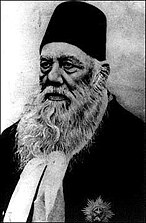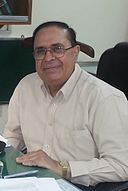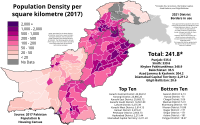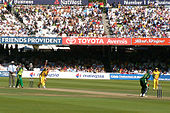Pakistan
Islamic Republic of Pakistan | |
|---|---|
Motto:
| |
Anthem:
| |
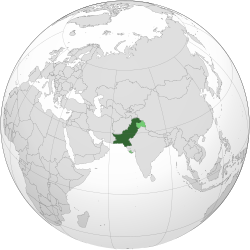 Land controlled by Pakistan shown in dark green; land claimed but not controlled shown in light green (see Kashmir conflict and Annexation of Junagadh) | |
| Capital | Islamabad 33°41′30″N 73°3′0″E / 33.69167°N 73.05000°E |
| Largest city | Karachi 24°51′36″N 67°0′36″E / 24.86000°N 67.01000°E |
| Official languages | |
| Native languages | Over 77 languages[4] |
| Religion |
|
| Demonym(s) | Pakistani |
| Government | Federal parliamentary Islamic republic |
| Asif Ali Zardari | |
| Shehbaz Sharif | |
| Yusuf Raza Gilani | |
| Ayaz Sadiq | |
| Yahya Afridi | |
| Legislature | Parliament |
| Senate | |
| National Assembly | |
| Independence from the United Kingdom | |
| 23 March 1940 | |
| 14 August 1947 | |
• Republic | 23 March 1956 |
| 8 December 1958 | |
| 16 December 1971 | |
| 14 August 1973 | |
| Area | |
• Total | 881,913 km2 (340,509 sq mi)[b][6] (33rd) |
• Water (%) | 2.86 |
| Population | |
• 2023 census | |
• Density | 273.8/km2 (709.1/sq mi) (56th) |
| GDP (PPP) | 2024 estimate |
• Total | |
• Per capita | |
| GDP (nominal) | 2024 estimate |
• Total | |
• Per capita | |
| Gini (2018) | low inequality |
| HDI (2022) | low (164th) |
| Currency | Pakistani rupee (₨) (PKR) |
| Time zone | UTC+05:00 (PKT) |
| DST is not observed. | |
| Date format |
|
| Drives on | Left[9] |
| Calling code | +92 |
| ISO 3166 code | PK |
| Internet TLD | |
Pakistan,[e] officially the Islamic Republic of Pakistan,[f] is a country in South Asia. It is the fifth-most populous country, with a population of over 241.5 million,[g] having the second-largest Muslim population as of 2023. Islamabad is the nation's capital, while Karachi is its largest city and financial centre. Pakistan is the 33rd-largest country by area. Bounded by the Arabian Sea on the south, the Gulf of Oman on the southwest, and the Sir Creek on the southeast, it shares land borders with India to the east; Afghanistan to the west; Iran to the southwest; and China to the northeast. It shares a maritime border with Oman in the Gulf of Oman, and is separated from Tajikistan in the northwest by Afghanistan's narrow Wakhan Corridor.
Pakistan is the site of several ancient cultures, including the 8,500-year-old Neolithic site of Mehrgarh in Balochistan, the Indus Valley Civilisation of the Bronze Age,[10] and the ancient Gandhara civilisation.[11] The regions that compose the modern state of Pakistan were the realm of multiple empires and dynasties, including the Gandhāra, the Achaemenid, the Maurya, the Kushan, the Parthian, the Paratarajas, the Gupta;[12] the Umayyad Caliphate in its southern regions, the Hindu Shahis, the Ghaznavids, the Delhi Sultanate, the Samma, the Shah Miris, the Mughals,[13] the Durranis, the Sikhs and most recently, the British Raj from 1858 to 1947.
Spurred by the Pakistan Movement, which sought a homeland for the Muslims of British India, and election victories in 1946 by the All-India Muslim League, Pakistan gained independence in 1947 after the Partition of the British Indian Empire, which awarded separate statehood to its Muslim-majority regions and was accompanied by an unparalleled mass migration and loss of life.[14][15] Initially a Dominion of the British Commonwealth, Pakistan officially drafted its constitution in 1956, and emerged as a declared Islamic republic. In 1971, the exclave of East Pakistan seceded as the new country of Bangladesh after a nine-month-long civil war. In the following four decades, Pakistan has been ruled by governments whose descriptions, although complex, commonly alternated between civilian and military, democratic and authoritarian, relatively secular and Islamist.[16]
Pakistan is considered a middle power nation,[17][h] with the world's sixth-largest standing armed forces. It is a declared nuclear-weapons state, and is ranked amongst the emerging and growth-leading economies,[18] with a large and rapidly growing middle class.[19][20] Pakistan's political history since independence has been characterized by periods of significant economic and military growth as well as those of political and economic instability. It is an ethnically and linguistically diverse country, with similarly diverse geography and wildlife. The country continues to face challenges, including poverty, illiteracy, corruption, and terrorism.[21][22][23] Pakistan is a member of the United Nations, the Shanghai Cooperation Organisation, the Organisation of Islamic Cooperation, the Commonwealth of Nations, the South Asian Association for Regional Cooperation, and the Islamic Military Counter-Terrorism Coalition, and is designated as a major non-NATO ally by the United States.
Etymology
The name Pakistan was coined by Choudhry Rahmat Ali, a Pakistan Movement activist, who in January 1933 first published it (originally as "Pakstan") in a pamphlet Now or Never, using it as an acronym.[24][25][26] Rahmat Ali explained: "It is composed of letters taken from the names of all our homelands, Indian and Asian, Panjab, Afghania, Kashmir, Sindh, and Baluchistan." He added, "Pakistan is both a Persian and Urdu word... It means the land of the Paks, the spiritually pure and clean."[27] Etymologists note that پاک pāk, is 'pure' in Persian and Pashto and the Persian suffix ـستان -stan means 'land' or 'place of'.[25]
Rahmat Ali's concept of Pakistan only related to the northwestern area of the Indian subcontinent. He also proposed the name "Banglastan" for the Muslim areas of Bengal and "Osmanistan" for Hyderabad State, as well as a political federation between the three.[28]
History
Indus Valley Civilisation
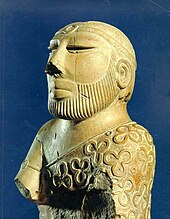
Some of the earliest ancient human civilisations in South Asia originated from areas encompassing present-day Pakistan.[30] The earliest known inhabitants in the region were Soanian during the Lower Paleolithic, of whom artefacts have been found in the Soan Valley of Punjab.[31] The Indus region, which covers most of the present-day Pakistan, was the site of several successive ancient cultures including the Neolithic (7000–4300 BCE) site of Mehrgarh,[32][33][34] and the 5,000-year history of urban life in South Asia to the various sites of the Indus Valley Civilisation, including Mohenjo-daro and Harappa.[35][36]
Vedic period

Following the decline of the Indus valley civilization, Indo-Aryan tribes moved into the Punjab from Central Asia in several waves of migration in the Vedic period (1500–500 BCE),[38] bringing with them their distinctive religious traditions and practices which fused with local culture.[39] The Indo-Aryans religious beliefs and practices from the Bactria–Margiana culture and the native Harappan Indus beliefs of the former Indus Valley civilization eventually gave rise to Vedic culture and tribes.[39] Most notable among them was Gandhara civilization, which flourished at the crossroads of India, Central Asia, and the Middle East, connecting trade routes and absorbing cultural influences from diverse civilizations.[40] The initial early Vedic culture was a tribal, pastoral society centered in the Indus Valley, of what is today Pakistan.[41] During this period, the Vedas, the oldest scriptures of Hinduism, were composed.[42][i]
Classical period

The western regions of Pakistan became part of Achaemenid Empire around 517 BCE.[44] In 326 BCE, Alexander the Great conquered the region by defeating various local rulers, most notably, the King Porus, at Jhelum.[45] It was followed by the Maurya Empire, founded by Chandragupta Maurya and extended by Ashoka the Great, until 185 BCE.[46][47][48] The Indo-Greek Kingdom founded by Demetrius of Bactria (180–165 BCE) included Gandhara and Punjab and reached its greatest extent under Menander (165–150 BCE), prospering the Greco-Buddhist culture in the region.[49][50][51] Taxila had one of the earliest universities and centres of higher education in the world, which was established during the late Vedic period in the 6th century BCE.[52] The ancient university was documented by the invading forces of Alexander the Great and was also recorded by Chinese pilgrims in the 4th or 5th century CE.[53][54][55] At its zenith, the Rai dynasty (489–632 CE) ruled Sindh and the surrounding territories.[56]
Islamic conquest
The Arab conqueror Muhammad ibn Qasim conquered Sindh and some regions of Punjab in 711 CE.[46][57] The Pakistan government's official chronology claims this as the time when the foundation of Pakistan was laid.[58] The Early Medieval period (642–1219 CE) witnessed the spread of Islam in the region.[59] Before the arrival of Islam beginning in the 8th century, the region of Pakistan was home to a diverse plethora of faiths, including Hinduism, Buddhism, Jainism and Zoroastrianism.[60][61] During this period, Sufi missionaries played a pivotal role in converting a majority of the regional population to Islam.[62] Upon the defeat of the Turk and Hindu Shahi dynasties which governed the Kabul Valley, Gandhara (present-day Khyber Pakhtunkhwa), and western Punjab in the 7th to 11th centuries CE, several successive Muslim empires ruled over the region, including the Ghaznavid Empire (975–1187 CE), the Ghorid Kingdom, and the Delhi Sultanate (1206–1526 CE).[63] The Lodi dynasty, the last of the Delhi Sultanate, was replaced by the Mughal Empire (1526–1857 CE).[64]

The Mughals introduced Persian literature and high culture, establishing the roots of Indo-Persian culture in the region.[65] In the region of modern-day Pakistan, key cities during the Mughal period were Multan, Lahore, Peshawar and Thatta,[66] which were chosen as the site of impressive Mughal buildings.[67] In the early 16th century, the region remained under the Mughal Empire.[68] In the 18th century, the slow disintegration of the Mughal Empire was hastened by the emergence of the rival powers of the Maratha Confederacy and later the Sikh Empire, as well as invasions by Nader Shah from Iran in 1739 and the Durrani Empire of Afghanistan in 1759.[9][69] The growing political power of the British in Bengal had not yet reached the territories of modern Pakistan.[70]
Colonial rule
None of modern Pakistan was under British rule until 1839 when Karachi, a small fishing village governed by Talpurs of Sindh with a mud fort guarding the harbour, was taken,[75][76] and used as an enclave with a port and military base for the First Afghan War that ensued.[77] The remainder of Sindh was acquired in 1843,[78] and subsequently, through a series of wars and treaties, the East India Company, and later, after the post-Sepoy Mutiny (1857–1858), direct rule by Queen Victoria of the British Empire, acquired most of the region.[79] Key conflicts included those against the Baloch Talpur dynasty, resolved by the Battle of Miani (1843) in Sindh,[80] the Anglo-Sikh Wars (1845–1849),[81] and the Anglo-Afghan Wars (1839–1919).[82] By 1893, all modern Pakistan was part of the British Indian Empire, and remained so until independence in 1947.[83]
Under British rule, modern Pakistan was primarily divided into the Sind Division, Punjab Province, and the Baluchistan Agency. The region also included various princely states, with the largest being Bahawalpur.[84][85]
The major armed struggle against the British in the region was the rebellion known as the Sepoy Mutiny in 1857.[86] Divergence in the relationship between Hinduism and Islam resulted in significant tension in British India, leading to religious violence. The language controversy further exacerbated tensions between Hindus and Muslims.[73][87] A Muslim intellectual movement, led by Sir Syed Ahmed Khan to counter the Hindu renaissance, advocated for the two-nation theory and led to the establishment of the All-India Muslim League in 1906.[71][72][73]
In March 1929, in response to the Nehru Report, Muhammad Ali Jinnah, the founder of Pakistan, issued his fourteen points, which included proposals to safeguard the interests of the Muslim minority in a united India. These proposals were rejected.[88][89][90] In his December 29, 1930 address, Allama Iqbal advocated the amalgamation of Muslim-majority states in North-West India, including Punjab, North-West Frontier Province, Sind, and Baluchistan.[90][91] The perception that Congress-led British provincial governments neglected the Muslim League from 1937 to 1939 motivated Jinnah and other Muslim League leaders to embrace the two-nation theory.[92][93] This led to the adoption of the Lahore Resolution of 1940, presented by Sher-e-Bangla A.K. Fazlul Haque, also known as the Pakistan Resolution.[94]
By 1942, Britain faced considerable strain during World War II, with India directly threatened by Japanese forces. Britain had pledged voluntary independence for India in exchange for support during the war. However, this pledge included a clause stating that no part of British India would be compelled to join the resulting dominion, which could be interpreted as support for an independent Muslim nation. Congress under the leadership of Mahatma Gandhi launched the Quit India Movement, demanding an immediate end to British rule. In contrast, the Muslim League chose to support the UK's war efforts, thereby nurturing the possibility of establishing a Muslim nation.[95][96]
Independence

The 1946 elections saw the Muslim League secure 90 percent of the Muslim seats, supported by the landowners of Sindh and Punjab. This forced the Indian National Congress, initially skeptical of the League's representation of Indian Muslims, to acknowledge its significance.[97] Jinnah's emergence as the voice of the Indian Muslims,[58] compelled the British to consider their stance, despite their reluctance to partition India. In a final attempt to prevent partition, they proposed the Cabinet Mission Plan.[98]
As the Cabinet Mission failed, the British announced their intention to end rule by June 1948.[99][100] Following rigorous discussions involving Viceroy of India, Lord Mountbatten of Burma, Muhammad Ali Jinnah of the All-India Muslim League, and Jawaharlal Nehru of Congress, the formal declaration to partition British India into two independent dominions—namely Pakistan and India—was issued by Mountbatten on the evening of 3 June 1947. In Mountbatten's oval office, the prime ministers of around a dozen major princely states gathered to receive their copies of the plan before its worldwide broadcast. At 7:00 P.M., All India Radio transmitted the public announcement, starting with the viceroy's address, followed by individual speeches from Nehru, and Jinnah. The founder of Pakistan Muhammad Ali Jinnah concluded his address with the slogan Pakistan Zindabad (Long Live Pakistan).[101]
As the United Kingdom agreed to the partitioning of India,[101] the modern state of Pakistan was established on 14 August 1947 (27th of Ramadan in 1366 of the Islamic Calendar, considered to be the most blessed date from an Islamic perspective).[102][103] This new nation amalgamated the Muslim-majority eastern and northwestern regions of British India, comprising the provinces of Balochistan, East Bengal, the North-West Frontier Province, West Punjab, and Sindh.[104]
In the riots that accompanied the partition in Punjab Province, between 200,000 and 2,000,000 people were killed in what some have described as a retributive genocide between the religions.[105] Around 50,000 Muslim women were abducted and raped by Hindu and Sikh men, while 33,000 Hindu and Sikh women experienced the same fate at the hands of Muslims.[106] Around 6.5 million Muslims moved from India to West Pakistan and 4.7 million Hindus and Sikhs moved from West Pakistan to India.[107] It was the largest mass migration in human history.[108] A subsequent dispute over the princely state of Jammu and Kashmir eventually sparked the Indo-Pakistani War of 1947–1948.[109]
Post Independence

After independence in 1947, Jinnah, the President of the Muslim League, became Pakistan's first Governor-General and the first President-Speaker of the Parliament, but he succumbed to tuberculosis on 11 September 1948.[111][112] Meanwhile, Pakistan's founding fathers agreed to appoint Liaquat Ali Khan, the secretary-general of the party, the nation's first Prime Minister.[110][111] From 1947 to 1956, Pakistan was a monarchy within the Commonwealth of Nations, and had two monarchs before it became a republic.[113]
The creation of Pakistan was never fully accepted by many British leaders including Lord Mountbatten.[114] Mountbatten expressed his lack of support and faith in the Muslim League's idea of Pakistan.[115] Jinnah refused Mountbatten's offer to serve as Governor-General of Pakistan.[116] When Mountbatten was asked by Collins and Lapierre if he would have sabotaged Pakistan had he known that Jinnah was dying of tuberculosis, he replied 'most probably'.[117]
"You are free; you are free to go to your temples, you are free to go to your mosques or to any other place of worship in this State of Pakistan. You may belong to any religion or caste or creed – that has nothing to do with the business of the State."
Maulana Shabbir Ahmad Usmani, a respected Deobandi alim (scholar) who held the position of Shaykh al-Islam in Pakistan in 1949, and Maulana Mawdudi of Jamaat-i-Islami played key roles in advocating for an Islamic constitution. Mawdudi insisted that the Constituent Assembly declare the "supreme sovereignty of God" and the supremacy of the shariah in Pakistan.[119]
The efforts of Jamaat-i-Islami and the ulama led to the passage of the Objectives Resolution in March 1949. This resolution, described by Liaquat Ali Khan as the second most significant step in Pakistan's history, affirmed that "sovereignty over the entire universe belongs to God Almighty alone and the authority which He has delegated to the State of Pakistan through its people for being exercised within the limits prescribed by Him is a sacred trust". It was later included as a preamble to the constitutions of 1956, 1962, and 1973.[120]
Democracy faced setbacks due to the martial law imposed by President Iskander Mirza, who was succeeded by General Ayub Khan. After adopting a presidential system in 1962, Pakistan witnessed significant growth until the second war with India in 1965, resulting in an economic downturn and widespread public discontent in 1967.[121][122] In 1969, President Yahya Khan consolidated control, but faced a devastating cyclone in East Pakistan resulting in 500,000 deaths.[123]
In 1970, Pakistan conducted its first democratic elections since independence, intending to transition from military rule to democracy. However, after the East Pakistani Awami League emerged victorious over the Pakistan Peoples Party (PPP), Yahya Khan and the military refused to transfer power.[124] This led to Operation Searchlight, a military crackdown, and eventually sparked the war of liberation by Bengali Mukti Bahini forces in East Pakistan,[125] described in West Pakistan as a civil war rather than a liberation struggle.[126]

Independent researchers estimate that between 300,000 and 500,000 civilians died during this period while the Bangladesh government puts the number of dead at three million,[128] a figure that is now nearly universally regarded as excessively inflated.[129] Some academics such as Rudolph Rummel and Rounaq Jahan say both sides committed genocide;[130] others such as Richard Sisson and Leo E. Rose believe there was no genocide.[131] In response to India's support for the insurgency in East Pakistan, preemptive strikes on India by Pakistan's air force, navy, and marines sparked a conventional war in 1971 that resulted in an Indian victory and East Pakistan gaining independence as Bangladesh.[132]
With Pakistan surrendering in the war,[133] Yahya Khan was replaced by Zulfikar Ali Bhutto as president; the country worked towards promulgating its constitution and putting the country on the road to democracy.[134][135] In 1972 Pakistan embarked on an ambitious plan to develop its nuclear deterrence capability with the goal of preventing any foreign invasion; the country's first nuclear power plant was inaugurated in that same year.[136][137] India's first nuclear test in 1974 gave Pakistan additional justification to accelerate its nuclear program.[137]
Democracy ended with a military coup in 1977 against the leftist PPP, which saw General Zia-ul-Haq become the president in 1978.[138] From 1977 to 1988, President Zia's corporatisation and economic Islamisation initiatives led to Pakistan becoming one of the fastest-growing economies in South Asia.[139] While building up the country's nuclear program, increasing Islamisation, and the rise of a homegrown conservative philosophy, Pakistan helped subsidise and distribute US resources to factions of the mujahideen against the USSR's intervention in communist Afghanistan.[140][141][142] Pakistan's North-West Frontier Province became a base for the anti-Soviet Afghan fighters, with the province's influential Deobandi ulama playing a significant role in encouraging and organising the 'jihad'.[143]
President Zia died in a plane crash in 1988, and Benazir Bhutto, daughter of Zulfikar Ali Bhutto, was elected as the country's first female Prime Minister. The PPP was followed by conservative Pakistan Muslim League (N) (PML (N)), and over the next decade the leaders of the two parties fought for power, alternating in office.[144] This period is marked by prolonged stagflation, political instability, corruption, misgovernment, geopolitical rivalry with India, and the clash of left wing-right wing ideologies.[145][146] As PML (N) secured a supermajority in elections in 1997,[147] Nawaz Sharif authorised nuclear testings, as a retaliation to the second nuclear tests conducted by India in May 1998.[148]

Military tension between the two countries in the Kargil district led to the Kargil War of 1999,[150][151] and turmoil in civil-military relations allowed General Pervez Musharraf to take over through a bloodless coup d'état.[152] Musharraf governed Pakistan as chief executive from 1999 to 2002 and as president from 2001 to 2008[153]—a period of enlightenment,[154][155] social liberalism,[156] extensive economic reforms,[157] and direct involvement in the US-led war on terrorism.[155] By its own financial calculations, Pakistan's involvement in the war on terrorism has cost up to $118 billion, over eighty one thousand casualties,[158] and more than 1.8 million displaced civilians.[159]
The National Assembly historically completed its first full five-year term on 15 November 2007.[160] After the assassination of Benazir Bhutto in 2007, the PPP secured the most votes in the elections of 2008, appointing party member Yusuf Raza Gilani as Prime Minister.[161] Threatened with impeachment, President Musharraf resigned on 18 August 2008, and was succeeded by Asif Ali Zardari.[162] Clashes with the judicature prompted Gilani's disqualification from the Parliament and as the Prime Minister in June 2012.[163] The general election held in 2013 saw the PML (N) achieve victory,[164] following which Nawaz Sharif was elected as Prime Minister for the third time.[165] In 2018, PTI won the general election and Imran Khan became the 22nd Prime Minister.[166] In April 2022, Shehbaz Sharif was elected as prime minister, after Imran Khan lost a no-confidence vote.[167] During 2024 general election, PTI-backed independents became the largest bloc,[168] but Shehbaz Sharif was elected prime minister for a second term, as a result of a coalition between PML (N) and PPPP.[169]
Geography
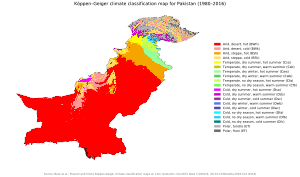
Pakistan's diverse geography and climate host a wide array of wildlife.[170] Covering 881,913 km2 (340,509 sq mi),[171] Pakistan's size is comparable to France and the UK combined.[172] It ranks as the 33rd-largest nation by total area,[173] but this varies based on Kashmir's disputed status. Pakistan boasts a 1,046 km (650 mi) coastline along the Arabian Sea and the Gulf of Oman,[174][175] and shares land borders totaling 6,774 km (4,209 mi), including 2,430 km (1,510 mi) with Afghanistan, 523 km (325 mi) with China, 2,912 km (1,809 mi) with India, and 909 km (565 mi) with Iran.[176] It has a maritime border with Oman,[177] and shares a border with Tajikistan via the Wakhan Corridor.[178] Situated at the crossroads of South Asia, the Middle East, and Central Asia,[179] Pakistan's location is geopolitically significant.[180] Geologically, Pakistan straddles the Indus–Tsangpo Suture Zone and the Indian tectonic plate in Sindh and Punjab, while Balochistan and most of Khyber Pakhtunkhwa sit on the Eurasian Plate, primarily on the Iranian plateau. Gilgit-Baltistan and Azad Kashmir, along the Indian plate's edge, are susceptible to powerful earthquakes.[181]

Pakistan's landscapes vary from coastal plains to glaciated mountains, offering deserts, forests, hills, and plateaus.[183] Pakistan is divided into three major geographic areas: the northern highlands, the Indus River plain, and the Balochistan Plateau.[184] The northern highlands feature the Karakoram, Hindu Kush, and Pamir mountain ranges, hosting some of the world's highest peaks, including five of the fourteen eight-thousanders (mountain peaks over 8,000 metres or 26,250 feet), notably K2 (8,611 m or 28,251 ft) and Nanga Parbat (8,126 m or 26,660 ft).[185][186] The Balochistan Plateau lies in the west and the Thar Desert in the east.[187][188][189] The 1,609 km (1,000 mi) Indus River and its tributaries traverse the nation from Kashmir to the Arabian Sea, sustaining alluvial plains along the Punjab and Sindh regions.[190]
The climate varies from tropical to temperate, with arid conditions in the coastal south. There is a monsoon season with frequent flooding due to heavy rainfall, and a dry season with significantly less rainfall or none at all.[191] Pakistan experiences four distinct seasons: a cool, dry winter from December through February; a hot, dry spring from March through May; the summer rainy season, or southwest monsoon period, from June through September; and the retreating monsoon period of October and November.[192] Rainfall varies greatly from year to year, with patterns of alternate flooding and drought common.[193]
Flora and fauna
The diverse landscape and climate in Pakistan support a wide range of trees and plants.[194] From coniferous alpine and subalpine trees like spruce, pine, and deodar cedar in the northern mountains to deciduous trees like shisham in the Sulaiman Mountains,[191] and palms such as coconut and date in the southern regions.[195][196] The western hills boast juniper, tamarisk, coarse grasses, and scrub plants.[197] Mangrove forests dominate the coastal wetlands in the south.[198] Coniferous forests span altitudes from 1,000 to 4,000 metres (3,300 to 13,100 feet) in most northern and northwestern highlands.[199] In Balochistan's xeric regions, date palms and Ephedra are prevalent.[195][200] In Punjab and Sindh's Indus plains, tropical and subtropical dry and moist broadleaf forests as well as tropical and xeric shrublands thrive.[201] Approximately 4.8% or 36,845.6 square kilometres (3,684,560 ha) of Pakistan was forested in 2021.[202][j]

Pakistan's fauna mirrors its diverse climate. The country boasts around 668 bird species,[204] including crows, sparrows, mynas, hawks, falcons, and eagles. Palas, Kohistan, is home to the western tragopan, with many migratory birds visiting from Europe, Central Asia, and India.[205] The southern plains harbor mongooses,[206] small Indian civet,[207] hares,[208] the Asiatic jackal,[209] the Indian pangolin,[210] the jungle cat,[211] and the sand cat.[212] Indus is home to mugger crocodiles,[213] while surrounding areas host wild boars,[214] deer,[215] and porcupines.[216] Central Pakistan's sandy scrublands shelter Asiatic jackals,[209] striped hyenas,[217] wildcats, and leopards. The mountainous north hosts a variety of animals like the Marco Polo sheep,[218] urial, markhor goat, ibex goat, Asian black bear, and Himalayan brown bear.[191]
The lack of vegetative cover, severe climate, and grazing impact on deserts have endangered wild animals.[219] The chinkara is the only animal found in significant numbers in Cholistan,[220] with a few nilgai along the Pakistan–India border and in some parts of Cholistan.[221] Rare animals include the snow leopard and the blind Indus river dolphin,[191] of which there are believed to be about 1,816 remaining, protected at the Indus Dolphin Reserve in Sindh.[222] In total, 174 species of mammals, 177 species of reptiles, 22 species of amphibians, 198 species of freshwater fish, 668 species of birds, over 5,000 species of insects, and over 5,700 species of plants have been recorded in Pakistan.[204] Pakistan faces deforestation, hunting, and pollution, with a 2019 Forest Landscape Integrity Index mean score of 7.42/10, ranking 41st globally out of 172 countries.[223]
Government and politics
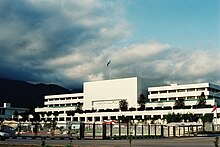
Pakistan operates as a democratic parliamentary federal republic, with Islam designated as the state religion.[224][225] Initially adopting a constitution in 1956, Pakistan saw it suspended by Ayub Khan in 1958, replaced by a second constitution in 1962.[226] A comprehensive constitution emerged in 1973, suspended by Zia-ul-Haq in 1977 but reinstated in 1985, shaping the country's governance.[176] The military's influence in mainstream politics has been significant throughout Pakistan's history.[227] The eras of 1958–1971, 1977–1988, and 1999–2008 witnessed military coups, leading to martial law and military leaders governing de facto as presidents.[228] Presently, Pakistan operates a multi-party parliamentary system,[229] with distinct checks and balances among government branches.[230] The first successful democratic transition occurred in May 2013.[231] Pakistani politics revolves around a blend of socialism, conservatism, and the third way,[232] with the three main political parties being the conservative PML (N), socialist PPP, and centrist PTI.[233] Constitutional amendments in 2010 curtailed presidential powers, enhancing the role of the prime minister.[234]
- Head of State: The ceremonial head of the state and civilian commander-in-chief of the Pakistan Armed Forces is the President, elected by an Electoral College.[233] The Prime Minister advises the President on key appointments, including military and judicial positions, and the President is constitutionally bound to act on this advice.[235][236] The President also holds powers to pardon and grant clemency.[237]
- Legislative: The bicameral legislature includes a 96-member Senate (upper house) and a 336-member National Assembly (lower house). National Assembly members are elected via first-past-the-post under universal adult suffrage, representing National Assembly constituencies. The constitution reserves 70 seats for women and religious minorities, allocated to political parties based on proportional representation. Senate members are elected by provincial legislators, ensuring equal representation across all provinces.[238]
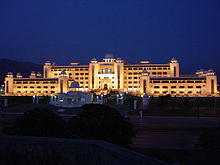
- Executive: The Prime Minister, typically the leader of the majority rule party or coalition in the National Assembly (the lower house),[239] serves as the country's chief executive and head of government. Responsibilities include forming a cabinet,[240] making executive decisions,[235] and appointing senior civil servants, subject to executive confirmation.[241]
- Provincial governments: Each of the four provinces follows a similar governance system, with a directly elected Provincial Assembly choosing the Chief Minister, usually from the largest party or coalition. Chief Ministers lead the provincial cabinet and oversee provincial governance.[242][243] The Chief Secretary, appointed by the Prime Minister, heads the provincial bureaucracy.[244] Provincial assemblies legislate and approve the provincial budget, typically presented by the provincial finance minister annually.[243][245] Ceremonial heads of provinces, the Provincial Governors, are appointed by the President based on the binding advice of the Prime Minister.[242][246]
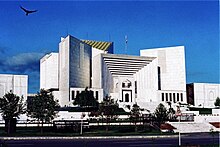
- Judicature: The judiciary in Pakistan has two classes: the superior and subordinate judiciary. The superior judiciary includes the Supreme Court of Pakistan,[247] Federal Shariat Court, and five high courts,[248] with the Supreme Court at the top. It's responsible for safeguarding the constitution.[247] Azad Kashmir and Gilgit-Baltistan have their own court systems.[249][250]
Role of Islam
Pakistan, the only country established in the name of Islam,[251] had overwhelming support among Muslims, especially in provinces like the United Provinces, where Muslims were a minority.[252] This idea, articulated by the Muslim League, the Islamic clergy, and Jinnah, envisioned an Islamic state.[253] Jinnah, closely associated with the ulama, was described upon his death by Maulana Shabbir Ahmad Usmani as the greatest Muslim after Aurangzeb, aspiring to unite Muslims worldwide under Islam.[254]
The Objectives Resolution of March 1949 marked the initial step towards this goal, affirming God as the sole sovereign.[120][255] Muslim League leader Chaudhry Khaliquzzaman asserted that Pakistan could only truly become an Islamic state after bringing all believers of Islam into a single political unit.[256] Keith Callard observed that Pakistanis believed in the essential unity of purpose and outlook in the Muslim world, expecting similar views on religion and nationality from Muslims worldwide.[257]

Pakistan's desire for a united Islamic bloc, called Islamistan, wasn't supported by other Muslim governments,[258] though figures like the Grand Mufti of Palestine, Al-Haj Amin al-Husseini, and leaders of the Muslim Brotherhood were drawn to the country. Pakistan's desire for an international organization of Muslim countries was fulfilled in the 1970s when the Organization of Islamic Conference (OIC) was formed.[259] East Pakistan's Bengali Muslims, opposed to an Islamist state, clashed with West Pakistanis who leaned towards Islamic identity.[260][261] The Islamist party Jamaat-e-Islami backed an Islamic state and opposed Bengali nationalism.[262]
After the 1970 general elections, the Parliament crafted the 1973 Constitution.[263] It declared Pakistan an Islamic Republic, with Islam as the state religion, and mandated laws to comply with Islamic teachings laid down in the Quran and Sunnah and that no law repugnant to such injunctions could be enacted.[264] Additionally, it established institutions like the Shariat Court and the Council of Islamic Ideology to interpret and apply Islam.[265]
Zulfikar Ali Bhutto faced opposition under the banner of Nizam-e-Mustafa ("Rule of the Prophet"),[266] advocating an Islamic state. Bhutto conceded to some Islamist demands before being ousted in a coup.[267]
General Zia-ul-Haq, after seizing power, committed to establishing an Islamic state and enforcing sharia law.[267] He instituted Shariat judicial courts,[268] and court benches,[269][270] to adjudicate using Islamic doctrine.[271] Zia aligned with Deobandi institutions,[272] exacerbating sectarian tensions with anti-Shia policies.[273]
Most Pakistanis, according to a Pew Research Center (PEW) poll, favor Sharia law as the official law,[274] and 94 percent of them identify more with religion than nationality compared to Muslims in other nations.[275]
Administrative units
| Administrative unit[276] | Capital[277][278][279] | Population[280][281][282] |
|---|---|---|
| Quetta | 14,894,402 | |
| Lahore | 127,688,922 | |
| Karachi | 55,696,147 | |
| Peshawar | 40,856,097 | |
| Gilgit | 1,492,924 | |
| Muzaffarabad | 4,179,428 | |
| Islamabad Capital Territory | Islamabad | 2,363,863 |
Pakistan, a federal parliamentary republic, consists of four provinces: Punjab, Khyber Pakhtunkhwa, Sindh, and Balochistan, along with three territories: Islamabad Capital Territory, Gilgit-Baltistan, and Azad Kashmir.[283] The Government of Pakistan governs the western parts of the Kashmir Region, organized into separate political entities, Azad Kashmir and Gilgit-Baltistan.[284] In 2009, the constitutional assignment (the Gilgit–Baltistan Empowerment and Self-Governance Order) granted Gilgit-Baltistan semi-provincial status, providing it with self-government.[285]
The local government system consists of districts, tehsils, and union councils, with an elected body at each tier.[286]
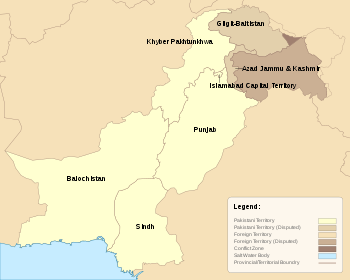
Foreign relations
Since independence, Pakistan has aimed to maintain an independent foreign policy.[287] Pakistan's foreign policy and geostrategy focus on the economy, security, national identity, and territorial integrity, as well as building close ties with other Muslim nations.[288] According to Hasan Askari Rizvi, a foreign policy expert, "Pakistan highlights sovereign equality of states, bilateralism, mutuality of interests, and non-interference in each other's domestic affairs as the cardinal features of its foreign policy."[289]
The Kashmir conflict remains a major issue between Pakistan and India, with three of their four wars fought over it.[290] Due partly to strained relations with India, Pakistan has close ties with Turkey and Iran, both focal points in its foreign policy.[291] Saudi Arabia also holds importance in Pakistan's foreign relations.[292]
As a non-signatory of the Treaty on Nuclear Non-Proliferation, Pakistan holds influence in the IAEA.[293] For years, Pakistan has blocked an international treaty to limit fissile material, arguing that its stockpile does not meet its long-term needs.[294] Pakistan's nuclear program in the 20th century aimed to counter India's nuclear ambitions in the region, and reciprocal nuclear tests ensued after India's nuclear tests, solidifying Pakistan as a nuclear power.[295] Pakistan maintains a policy of Full spectrum deterrence, considering its nuclear program vital for deterring foreign aggression.[296]
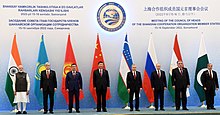
Located strategically in the world's major maritime oil supply lines and communication fiber optic corridors, Pakistan also enjoys proximity to the natural resources of Central Asian countries.[298] Pakistan actively participates in the United Nations with a Permanent Representative representing its positions in international politics.[299] It has advocated for the concept of "enlightened moderation" in the Muslim world.[300] Pakistan is a member of the Commonwealth of Nations, SAARC, ECO,[301][302] and the G20 developing nations.[303]

Pakistan is designated as an "Iron Brother" by China, emphasizing the significance of their close and supportive relationship.[305] In the 1950s, Pakistan opposed the Soviet Union for geopolitical reasons. During the Soviet–Afghan War in the 1980s, it was a close ally of the United States.[289] Relations with Russia have improved since the end of the Cold War,[306] but Pakistan's relationship with the United States has been "on-and-off."[289] Initially a close ally during the Cold War,[307] Pakistan's relations with the US soured in the 1990s due to sanctions over its secretive nuclear program.[308] Since 9/11, Pakistan has been a US ally on counterterrorism, but their relationship has been strained due to diverging interests and mistrust during the 20-year war and terrorism issues. Although Pakistan was granted major non-NATO ally status by the U.S. in 2004,[309] it faced accusations of supporting the Taliban insurgents in Afghanistan.[310]
Pakistan does not have formal diplomatic relations with Israel; nonetheless, an exchange occurred between the two countries in 2005, with Turkey acting as an intermediary.[311]
Relations with China

Pakistan was among the first nations to establish formal diplomatic ties with the China,[314] forging a strong relationship since China's 1962 conflict with India, culminating in a special bond.[315] During the 1970s, Pakistan acted as an intermediary in U.S.-China rapprochement,[316] facilitating US President Richard Nixon's historic visit to China.[317][318] Despite changes in Pakistani governance and regional/global dynamics, China's influence in Pakistan remains paramount.[316] In reciprocation, China stands as Pakistan's largest trading partner, with substantial investment in Pakistani infrastructure, notably the Gwadar port.[319] In 2015 alone, they inked 51 agreements and Memorandums of Understanding (MoUs) for cooperative efforts.[320] Both nations signed a Free Trade Agreement in 2006,[321] with China making its largest investment in Pakistan's history through CPEC.[322] Pakistan acts as China's liaison to the Muslim world,[323] and both nations support each other on sensitive issues like Kashmir, Taiwan, Xinjiang, and more.[324]
Relations with the Muslim world
After Independence, Pakistan vigorously pursued bilateral relations with other Muslim countries.[325] The Ali brothers sought to project Pakistan as the natural leader of the Islamic world, partly due to its significant manpower and military strength.[326] Khaliquzzaman, a prominent Muslim League leader, declared Pakistan's ambition to unite all Muslim countries into Islamistan, a pan-Islamic entity.[327]
These developments, alongside Pakistan's creation, didn't receive approval from the United States, with British Prime Minister Clement Attlee expressing a hope for India and Pakistan to reunite.[328] However, due to a nationalist awakening in the Arab world at that time, there was little interest in Pakistan's Pan-Islamic aspirations.[329] Some Arab countries perceived the 'Islamistan' project as Pakistan's bid to dominate other Muslim states.[330]
Pakistan's founder, Muhammad Ali Jinnah, consistently advocated for the Palestinian cause, shaping Pakistan's foreign policy to support Palestinian rights within the broader framework of Muslim solidarity.[331] During the 1967 Arab-Israel war, Pakistan supported the Arab states and played a key role in securing Iran's backing for the Arab cause both within the U.N. and beyond.[332]
Pakistan's relations with Iran have been strained by sectarian tensions,[333] with both Iran and Saudi Arabia using Pakistan as a battleground for their proxy sectarian war.[334] Since the early days of the Iran–Iraq war, President Zia-ul-Haq played an important mediatory role, with Pakistan actively engaging in efforts to end the conflict.[335][336] Pakistan provided support to Saudi Arabia during the Gulf War.[337] Pakistan chose to remain neutral during Operation Decisive Storm, refraining from sending military support to Saudi Arabia in its offensive against Yemen. Instead, Pakistan aimed to play a proactive diplomatic role in resolving the crisis,[338] which led to tensions between the two countries.[337] In 2016, Pakistan mediated between Saudi Arabia and Iran following the execution of Shia cleric Nimr al-Nimr, with visits to both countries by then Prime Minister Nawaz Sharif and the Chief of Army Staff, Raheel Sharif.[339]
Pakistan provided refuge to millions of displaced Afghans after the Soviet invasion and supported the Afghan mujahideen in their efforts to expel Soviet forces from Afghanistan.[340] After the Soviets withdrew, infighting erupted among Mujahideen factions over control of Afghanistan. Pakistan facilitated peace talks to help end the conflict.[341] After four years of unresolved conflict between rival Mujahideen groups, Pakistan helped establish the Taliban as a stabilizing force.[342] Pakistan's support for the Sunni Taliban in Afghanistan challenged Shia-led Iran, which opposed a Taliban-controlled Afghanistan.[334]
Pakistan vigorously advocated for self-determination among Muslims globally. Its efforts in supporting independence movements in countries like Indonesia, Algeria, Tunisia, Morocco, and Eritrea fostered strong ties.[343] Due to its support for Azerbaijan in the Nagorno-Karabakh conflict, Pakistan has not established diplomatic relations with Armenia.[344][345]
Pakistan and Bangladesh have experienced strained relations, particularly under the Awami League governments led by Sheikh Hasina, driven by her pro-India stance and historical grievances.[346]
Pakistan, a prominent member of the Organisation of Islamic Cooperation (OIC), prioritizes maintaining cultural, political, social, and economic relations with Arab and other Muslim-majority nations in its foreign policy.[347]
Kashmir conflict

Kashmir, a Himalayan region at the northern tip of the Indian subcontinent, was governed as the autonomous princely state of Jammu and Kashmir during the British Raj before the Partition of India in August 1947. This sparked a major territorial dispute between India and Pakistan, resulting in several conflicts over the region. India controls about 45.1% of Kashmir, including Jammu and Kashmir and Ladakh, while Pakistan controls roughly 38.2%, comprising Azad Jammu and Kashmir and Gilgit−Baltistan. Additionally, about 20% of the region, known as Aksai Chin and the Shaksgam Valley, is under Chinese control.[349] India claims the entire Kashmir region based on the Instrument of Accession signed by the princely state's ruler, Maharaja Hari Singh,[350] while Pakistan argues for its Muslim-majority population,[351] and geographical proximity to Pakistan.[352] The United Nations was involved in resolving the conflict, leading to a ceasefire in 1949 and the establishment of the Line of Control (LoC) as a de facto border.[353] India, fearing Kashmir's secession, did not hold the promised plebiscite, as it believed Kashmiris would vote to join Pakistan.[354]

Pakistan claims that its position is for the right of the Kashmiri people to determine their future through impartial elections as mandated by the United Nations, while India has stated that Kashmir is an "integral part" of India, referring to the 1972 Simla Agreement and to the fact that regional elections take place regularly.[356] Certain Kashmiri independence groups believe that Kashmir should be independent of both India and Pakistan.[357]
Military

The armed forces of Pakistan rank sixth globally in personnel size, with about 660,000 on active duty and 291,000 paramilitary personnel as of 2024.[358] Established in 1947, they've wielded significant influence over national politics.[359] The main branches include the Army, Navy, and Air Force, supported by numerous paramilitaries.[360]
The Chairman of the Joint Chiefs of Staff Committee (CJCSC) is the highest-ranking military officer, advising the civilian government. However, they lack direct command over the branches and serve as intermediaries, ensuring communication between the military and civilian leadership. Overseeing the Joint Staff Headquarters, they coordinate inter-service cooperation and joint military missions.[361]
Command and control over Pakistan's strategic arsenal development and employment is vested in the National Command Authority, overseeing work on nuclear doctrine to maintain Full spectrum deterrence.[148]
The United States, Turkey, and China maintain close military relations with Pakistan Armed Forces, regularly exporting military equipment and technology transfer.[362] Pakistan was the 5th-largest recipient and importer of arms between 2019 and 2023.[363]
Military history
Since 1947, Pakistan has been involved in four conventional wars with India.[364] The first conflict took place in Kashmir and ended in a United Nations-mediated ceasefire, with Pakistan gaining control of one-third of the region.[365] Territorial disputes led to another war in 1965. In 1971, India and Pakistan fought another war over East Pakistan, with Indian forces aiding its independence, leading to the creation of Bangladesh.[366] Tensions in Kargil brought the two countries to the brink of war.[367]
During the Soviet-Afghan War, Pakistan's intelligence community, mostly the ISI, coordinated US resources to support Afghan mujahideen and foreign fighters against Soviet presence.[368] The PAF engaged with Soviet and Afghan Air Forces during the conflict.[369] Pakistan has been an active participant in UN peacekeeping missions,[370] playing a major role in operations like the rescue mission in Mogadishu, Somalia, in 1993.[371] According to UN reports, the Pakistani military is the third largest troop contributor to UN peacekeeping missions after Ethiopia and India.[372]
Pakistan has deployed its military in some Arab countries, providing defense, training, and advisory roles.[373] The PAF and Navy's fighter pilots served in Arab nations' militaries against Israel in the Six-Day War and the Yom Kippur War.[374] Pakistani special forces assisted Saudi forces in Mecca during the Grand Mosque Seizure.[375] Pakistan also sent 5,000 troops as part of a US-led coalition for the defense of Saudi Arabia during the Gulf War.[376]
Despite the UN arms embargo on Bosnia, the ISI under General Javed Nasir airlifted anti-tank weapons and missiles to Bosnian mujahideen, shifting the tide in favor of Bosnian Muslims. ISI, under Nasir's leadership, supported Chinese Muslims in Xinjiang, rebel groups in the Philippines, and religious groups in Central Asia.[377][378]
Since 2004, the military has been engaged in an insurgency in Khyber Pakhtunkhwa province, primarily against Tehrik-i-Taliban factions. Major operations include Operation Black Thunderstorm, Operation Rah-e-Nijat, and Operation Zarb-e-Azb.[379][380]
Law enforcement
Law enforcement in Pakistan consists of federal and provincial police agencies. Each of the four provinces (Punjab, Sindh, Khyber Pakhtunkhwa, and Balochistan) has its own police force, while the Islamabad Capital Territory (ICT) has the Islamabad Police.[381] Provincial police forces are led by an Inspector-General of Police (IGP) appointed by provincial governments. However, top officers are from the Police Service of Pakistan (PSP), ensuring national standards across provincial forces.
Specialized Units:
- National Highways & Motorway Police (NHMP): Enforces traffic laws and ensures safety on Pakistan's inter-provincial motorway network.
- Elite Police Units: Each provincial police force, such as the Punjab Elite Force, focuses on counter-terrorism operations and high-risk situations.
The Civil Armed Forces (CAF) support regular law enforcement agencies, aiding in tasks like riot control, counter-insurgency, and border security, enhancing Pakistan's law enforcement capabilities.[382]
The National Intelligence Coordination Committee oversees intelligence activities at federal and provincial levels, including the ISI, MI, IB, FIA, Police, and Civil Armed Forces.[383] Pakistan's primary intelligence agency, the Inter-Services Intelligence (ISI), was established within a year of Pakistan's independence in 1947.[384][385]
Human rights
In 2018, Pakistan ranked 139 out of 180 countries in the Press Freedom Index by Reporters Without Borders, highlighting restrictions on freedom of the press.[386] Television stations and newspapers face closures for publishing reports critical of the government or military.[387] Male homosexuality is illegal in Pakistan, punishable with up to life in prison.[388]
Economy
| Economic indicators | ||
|---|---|---|
| GDP (PPP) | $1.254 trillion (2019) | [389] |
| GDP (nominal) | $284.2 billion (2019) | [390] |
| Real GDP growth | 3.29% (2019) | [391] |
| CPI inflation | 10.3% (2019) | [392] |
| Unemployment | 5.7% (2018) | [393] |
| Labor force participation rate | 48.9% (2018) | [394] |
| Total public debt | $106 billion (2019) | |
| National wealth | $465 billion (2019) | [395] |
Pakistan's economy ranks 24th globally by purchasing power parity (PPP) and 43rd by nominal GDP. Historically, Pakistan was part of the wealthiest region in the first millennium CE, but lost ground to regions like China and Western Europe by the 18th century.[396] Pakistan is a developing country,[397] and part of the Next Eleven, poised to become one of the world's largest economies in the 21st century, alongside the BRICS.[398]
In recent years, Pakistan has faced social instability and macroeconomic imbalances, with deficiencies in services like rail transportation and electrical energy generation.[399] The semi-industrialized economy has growth centers along the Indus River.[400][401][402] The diversified economies of Karachi and Punjab's urban centers coexist with less-developed areas in other parts of the country, particularly in Balochistan.[401] Pakistan ranks as the 67th-largest export economy and the 106th-most complex economy globally, with a negative trade balance of US$23.96 billion in fiscal year 2015–16.[403][404]
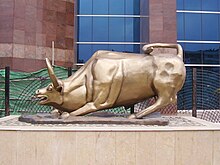
As of 2022[update], Pakistan's estimated nominal GDP is US$376.493 billion.[405] The GDP by PPP is US$1.512 trillion. The estimated nominal per capita GDP is US$1,658, the GDP (PPP)/capita is US$6,662 (international dollars),[389] According to the World Bank, Pakistan has important strategic endowments and development potential. The increasing proportion of Pakistan's youth provides the country with both a potential demographic dividend and a challenge to provide adequate services and employment.[406] 21.04% of the population live below the international poverty line of US$1.25 a day. The unemployment rate among the aged 15 and over population is 5.5%.[407] Pakistan has an estimated 40 million middle class citizens, projected to increase to 100 million by 2050.[408] A 2015 report published by the World Bank ranked Pakistan's economy at 24th-largest[409] in the world by purchasing power and 41st-largest[410] in absolute terms. It is South Asia's second-largest economy, representing about 15.0% of regional GDP.[411]
Pakistan's economic growth varied over time, with slow progress during democratic transitions but robust expansion under martial law, lacking sustainable foundations.[122] Rapid reforms in the early to mid-2000s, including increased development spending, reduced poverty by 10% and boosted GDP by 3%.[381][412] The economy cooled post-2007,[381] with inflation peaking at 25.0% in 2008,[413] necessitating IMF intervention to prevent bankruptcy.[414] The Asian Development Bank later noted easing economic strain in Pakistan.[415] Inflation for fiscal year 2010–11 stood at 14.1%.[416] Since 2013, Pakistan's economy has seen growth under an IMF program. Goldman Sachs predicted Pakistan's economy could grow 15 times by 2050,[417] and Ruchir Sharma in his 2016 book anticipated a transformation to a middle-income country by 2020.[418]
Pakistan's vast natural commodity production and 10th-largest labour market, along with a US$19.9 billion contribution from its 7-million-strong diaspora in 2015–16,[419][420][421] position it significantly. However, Pakistan's global export share is declining, accounting for just 0.13% in 2007 according to the World Trade Organization.[422]
Agriculture and mining sector

The Pakistani economy has shifted from agriculture to services, with agriculture contributing only 20.9% of the GDP as of 2015.[424] Despite this, Pakistan's wheat production in 2005 surpassed Africa's and nearly matched South America's, highlighting its agricultural significance.[425] The sector employs 43.5% of the labor force and is a major source of foreign exchange.[424][426]
Manufactured exports, heavily reliant on agricultural raw materials like cotton and hides, face inflationary pressures due to supply shortages and market disruptions. Pakistan ranks fifth in cotton production, self-sufficient in sugarcane, and the fourth-largest milk producer globally. Though land and water resources haven't increased proportionately, productivity gains, especially from the Green Revolution in the late 1960s and 1970s, significantly boosted wheat and rice yields. Private tube wells and High Yielding Varieties (HYVs) further augmented crop yields.[427] Meat industry accounts for 1.4 percent of overall GDP.[428]
Industry
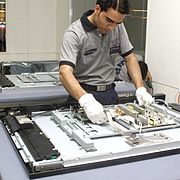
Industry, constituting 19.74% of GDP and 24% of total employment, is the second-largest sector. Large-scale manufacturing (LSM) dominates, representing 12.2% of GDP, with cement production thriving due to demand from Afghanistan and the domestic real estate sector.[430] In 2013, Pakistan exported 7,708,557 metric tons of cement, with an installed capacity of 44,768,250 metric tons.[431] The textile industry, a key player in Pakistan's manufacturing, contributes 9.5% to GDP and employs around 15 million people. Pakistan ranks fourth globally in cotton production, with substantial spinning capacity, making it a major exporter of textile products in Asia.[432] China is a significant buyer of Pakistani textiles, importing US$1.527 billion worth of textiles last fiscal year.[433]
Services
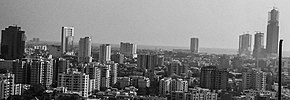
As of 2014–15, the services sector contributes 58.8% to GDP,[424] serving as the main driver of economic growth in Pakistan,[434] with a consumption-oriented society. The sector's growth rate surpasses that of agriculture and industry, accounting for 54% of GDP and over one-third of total employment. It has strong linkages with other sectors, providing essential inputs to agriculture and manufacturing.[435] Pakistan's IT sector is one of the fastest-growing, ranked 110th for ICT development by the World Economic Forum.[436] With around 82 million internet users as of May 2020, Pakistan ranks 9th globally,[437][438] and its ICT industry is projected to exceed $10 billion by 2020.[439] With 12,000 employees, Pakistan is among the top five freelancing nations,[440] and its export performance in telecom, computer, and information services has notably improved.[441]
Tourism

With its diverse cultures, landscapes, and attractions, Pakistan drew around 6.6 million foreign tourists in 2018.[442] However, this was a decline from the peak of tourism in the 1970s driven by the popular Hippie trail.[443] Pakistan boasts attractions from mangroves in the south to Himalayan hill stations in the northeast, including ancient Buddhist ruins of Takht-i-Bahi and Taxila, the 5,000-year-old Indus Valley civilization sites such as Mohenjo-daro and Harappa,[444] and numerous mountain peaks over 7,000 metres (23,000 feet).[445] The northern part of Pakistan boasts numerous old fortresses, showcasing ancient architecture. It encompasses the Hunza and Chitral valleys, where the small pre-Islamic Kalasha community resides, claiming descent from Alexander the Great.[446] Lahore, Pakistan's cultural capital, showcases numerous examples of Mughal architecture, including the Badshahi Masjid, the Shalimar Gardens, the Tomb of Jahangir, and the Lahore Fort. Following the 2005 Kashmir earthquake, The Guardian highlighted "The top five tourist sites in Pakistan" to boost tourism, featuring destinations like Taxila, Lahore, the Karakoram Highway, Karimabad, and Lake Saiful Muluk.[447] Festivals and government initiatives aim to promote Pakistan's cultural heritage.[448] In 2015, the World Economic Forum ranked Pakistan 125th out of 141 countries in its Travel & Tourism Competitiveness Report.[449]
Infrastructure
Pakistan was lauded as the top nation for infrastructure development in South Asia during the 2016 annual meetings of the IMF and World Bank.[450]
Power and energy

As of May 2021, Pakistan operates six licensed commercial nuclear power plants.[451] The Pakistan Atomic Energy Commission (PAEC) oversees these plants, while the Pakistan Nuclear Regulatory Authority ensures their safe operation.[452] These plants contribute approximately 5.8% to Pakistan's electricity supply, while fossil fuels (crude oil and natural gas) provide 64.2%, hydroelectric power provides 29.9%, and coal contributes 0.1%.[453][454] The KANUPP-I, Pakistan's first commercial nuclear power plant, was supplied by Canada in 1971. Sino-Pakistani nuclear cooperation began in the 1980s, leading to the establishment of CHASNUPP-I. In 2005, both countries proposed a joint energy security plan, aiming for a generation capacity exceeding 160,000 MWe by 2030. Pakistan's Nuclear Energy Vision 2050 targets a capacity of 40,000 MWe,[455] with 8,900 MWe expected by 2030.[456]
In June 2008, the nuclear complex at Chashma in Punjab Province expanded with the installation of Chashma-III and Chashma–IV reactors, each with 325–340 MWe, costing ₨129 billion, with ₨80 billion from international sources, mainly China. Another agreement for China's assistance was signed in October 2008, seen as a response to the US–India agreement. The project's cost was then US$1.7 billion, with a foreign loan of US$1.07 billion. In 2013, Pakistan established a second nuclear complex in Karachi with plans for additional reactors, similar to Chashma.[457] Electrical energy in Pakistan is generated by various corporations and distributed evenly among the four provinces by the National Electric Power Regulatory Authority (NEPRA). However, Karachi-based K-Electric and Water and Power Development Authority (WAPDA) generate much of the electricity used in Pakistan and collect revenue nationwide.[458] In 2023, Pakistan's installed electricity generation capacity was ~45,885 MWt.[459] Pakistan produced 1,135 megawatts of renewable energy for the month of October 2016. Pakistan expects to produce 10,000 megawatts of renewable energy by 2025.[460]
Transport
Pakistan boasts 2567 km of motorways and approximately 263,942 km of highways, which handle 92% of passengers and 96% of freight traffic. Despite constituting only 4.6% of the total road length, these north–south links manage 85% of the nation's traffic. They connect southern seaports such as Karachi port and Port Qasim in Sindh, along with Gwadar Port and Port of Pasni in Balochistan, to populous provinces like Punjab and Khyber Pakhtunkhwa domestically, and neighboring countries like Afghanistan, Central Asia, and China through the China Pakistan Economic Corridor.[461][462][463][464] According to the WEF's Global Competitiveness Report, Pakistan's port infrastructure quality ratings rose from 3.7 to 4.1 between 2007 and 2016.[465] The railway's share of inland traffic is reduced to below 8% for passengers and 4% for freight.[424] This shift led to a decrease in total rail track from 8,775 kilometres (5,453 miles) in 1990–91 to 7,791 kilometres (4,841 miles) in 2011.[462][461]
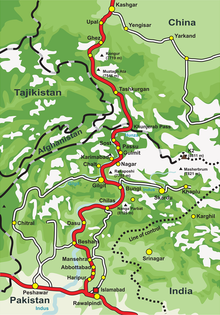
The transport landscape of Pakistan features various modern transit systems. The Orange Line Metro Train in Lahore, inaugurated in 2020,[466] spans 27.1 km (16.8 mi),[467] and includes both elevated and underground sections, accommodating over 250,000 passengers daily.[468] Lahore also boasts the Lahore Metrobus, the first of its kind in Pakistan, operational since February 2013.[469] The Rawalpindi-Islamabad Metrobus, stretching 48.1 km, commenced its first phase in June 2015, with subsequent extensions, and employs e-ticketing and an Intelligent Transportation System.[470][471] Multan Metrobus, inaugurated in January 2017, serves Multan with its rapid transit services.[472][473] Peshawar's Bus Rapid Transit, inaugurated in August 2020, marks the fourth BRT system in Pakistan. Karachi's Green Line Metrobus, operational since December 2021, is part of a larger metrobus project financed by the Government of Pakistan and initiated in February 2016.[474][475][476] Meanwhile, Faisalabad awaits its proposed rapid transit project, the Faisalabad Metrobus.[477] Karachi Circular Railway, partially revived in November 2020, offers public transit services in the Karachi metropolitan area.[478][479] Additionally, plans are underway to resurrect Karachi's tramway service, which ceased operations in 1975, in collaboration with Austrian experts.[480][481]
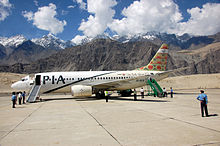
As of 2013, Pakistan boasts approximately 151 airports and airfields, encompassing both military and civilian installations.[482] Despite Jinnah International Airport serving as the primary international gateway, significant international traffic also flows through Lahore, Islamabad, Peshawar, Quetta, Faisalabad, Sialkot, and Multan airports. The civil aviation industry, deregulated in 1993, operates with a blend of public and private entities while state-owned Pakistan International Airlines (PIA) dominates, carrying 73% of domestic passengers and all domestic freight.
Science and technology
Developments in science and technology have played a significant role in Pakistan's infrastructure, linking the nation to the global community.[483] Each year, the Pakistan Academy of Sciences and the government invite scientists worldwide to the International Nathiagali Summer College on Physics.[484] In 2005, Pakistan hosted an international seminar on "Physics in Developing Countries" for the International Year of Physics.[485] Pakistani theoretical physicist Abdus Salam won a Nobel Prize in Physics for his work on the electroweak interaction.[486] Pakistani scientists have made notable contributions in mathematics, biology, economics, computer science, and genetics.[487]
In chemistry, Salimuzzaman Siddiqui identified the medicinal properties of the neem tree's components.[488][489] Ayub K. Ommaya developed the Ommaya reservoir for treating brain conditions.[490] Scientific research is integral to Pakistani universities, national laboratories, science parks, and the industry.[491] Abdul Qadeer Khan spearheaded Pakistan's HEU-based gas-centrifuge uranium enrichment program for its atomic bomb project.[492] He established the Kahuta Research Laboratories (KRL) in 1976, serving as both its senior scientist and the Director-General until his retirement in 2001. Besides atomic bomb project, he made significant contributions in molecular morphology, physical martensite, and their applications in condensed and material physics.[493]
In 2010, Pakistan ranked 43rd globally in published scientific papers.[494] The influential Pakistan Academy of Sciences guides the government on science policies.[495] Pakistan was ranked 91st in the Global Innovation Index by 2024.[496]
The 1960s marked the rise of Pakistan's space program, led by SUPARCO, yielding advancements in rocketry, electronics, and aeronomy. Notably, Pakistan launched its first rocket into space, pioneering South Asia's space exploration.[497] In 1990, it successfully launched its first satellite, becoming the first Muslim nation and second in South Asia to achieve this milestone.[498]
Pakistan witnessed a fourfold increase in its scientific productivity in the past decade surging from approximately 2,000 articles per year in 2006 to more than 9,000 articles in 2015. Making Pakistan's cited article's higher than the BRIC countries put together.
Following the 1971 war with India, Pakistan hastily developed atomic weapons to deter foreign intervention and entered the atomic age.[500] Tensions with India led to Pakistan's 1998 underground nuclear tests, making it the seventh country to possess such weapons.[501]
Pakistan is the sole Muslim nation active in Antarctica research, maintaining its Jinnah Antarctic Research Station since 1992.[502] By May 2020, Pakistan had 82 million internet users, ranking ninth globally.[437][438] The government invests heavily in information technology projects, focusing on e-government and infrastructure.[503]
Demographics
Pakistan had a population of 241,495,112 according to the final results of the 2023 Census.[504][505][506] This figure includes Pakistan's four provinces e.g. Punjab, Sindh, KPK, Balochistan and Islamabad Capital Territory. AJK and Gilgit-Baltistan's census data is yet to be approved by CCI Council of Pakistan. Pakistan is the world's fifth most populous country.[507]
Between 1951 and 2017, Pakistan's population expanded over sixfold, going from 33.7 million to 207.7 million. The country has a relatively high, although declining, growth rate supported by high birth rates and low death rates. Between 1998 and 2017, the average annual population growth rate stood at +2.40%.
Dramatic social changes have led to urbanization and the emergence of two megacities: Karachi and Lahore. The country's urban population more than tripled between 1981 and 2017 (from 23.8 million to 75.7 million), as Pakistan's urbanisation rate rose from 28.2% to 36.4%. Even with this, the nation's urbanisation rate remains one of the lowest in the world, and in 2017, over 130 million Pakistanis (making up nearly 65% of the population) lived in rural areas.
Due to a high fertility rate, which was estimated at 3.5 in 2022, Pakistan has one of the world's youngest populations. The 2017 census recorded that 40.3% of the country's population was under the age of 15, while only 3.7% of Pakistanis were aged 65 or more.[508] The median age of the country was 19,[508] while its sex ratio was recorded to be 105 males per 100 females.[504]
The demographic history of Pakistan from the ancient Indus Valley civilization to the modern era includes the arrival and settlement of many cultures and ethnic groups in the modern region of Pakistan from Eurasia and the nearby Middle East. Because of this, Pakistan has a multicultural, multilinguistic, and multiethnic society. Despite Urdu being Pakistan's lingua franca, estimates on how many languages are spoken in the country range from 75 to 85,[509][510] and in 2023, the country's three largest ethnolinguistic groups were the Punjabis (making up 36.98% of the total population), the Pashtuns (18.15%), and the Sindhis (14.31%).[511] Pakistan is also thought to have the world's fourth-largest refugee population, estimated at 1.4 million in mid-2021 by the UNHCR.[512]Urbanisation
Since independence due to the partition of India, urbanisation has surged for various reasons. In the south, Karachi stands as the most populous commercial hub along the Indus River.[513] In the east, west, and north, a dense population arc spans cities like Lahore, Faisalabad, Rawalpindi, Islamabad, Sargodha, Gujranwala, Sialkot, Gujrat, Jhelum, Sheikhupura, Nowshera, Mardan, and Peshawar. By 1990–2008, city dwellers constituted 36% of Pakistan's population, making it South Asia's most urbanized nation, with over 50% living in towns of 5,000+ inhabitants.[514] Immigration, both domestic and international, significantly fuels urban growth. Migration from India, especially to Karachi, the largest metropolis, and from nearby countries, accelerates urbanization, posing new political and socio-economic challenges. Economic shifts like the green revolution and political developments also play crucial roles.[515]
| Rank | Name | Province | Pop. | Rank | Name | Province | Pop. | ||
|---|---|---|---|---|---|---|---|---|---|
 Karachi  Lahore | 1 | Karachi | Sindh | 18,868,021 | 11 | Sargodha | Punjab | 975,886 |  Faisalabad  Rawalpindi |
| 2 | Lahore | Punjab | 13,004,135 | 12 | Sialkot | Punjab | 911,817 | ||
| 3 | Faisalabad | Punjab | 3,691,999 | 13 | Bahawalpur | Punjab | 903,795 | ||
| 4 | Rawalpindi | Punjab | 3,357,612 | 14 | Jhang | Punjab | 606,533 | ||
| 5 | Gujranwala | Punjab | 2,511,118 | 15 | Sheikhupura | Punjab | 591,424 | ||
| 6 | Multan | Punjab | 2,215,381 | 16 | Gujrat | Punjab | 574,240 | ||
| 7 | Hyderabad | Sindh | 1,921,275 | 17 | Sukkur | Sindh | 563,851 | ||
| 8 | Peshawar | Khyber Pakhtunkhwa | 1,905,975 | 18 | Larkana | Sindh | 551,716 | ||
| 9 | Quetta | Balochistan | 1,565,546 | 19 | Sahiwal | Punjab | 538,344 | ||
| 10 | Islamabad | Capital Territory | 1,108,872 | 20 | Okara | Punjab | 533,693 | ||
Ethnicity and languages
Pakistan is a diverse society with estimates suggesting it has between 75 and 85 languages.[518][519] Urdu and English serve as the official languages, with Urdu being a unifying force among over 75% of Pakistanis.[520][521] According to the 2023 national census, the largest ethnolinguistic groups include the Punjabis (36.98%), Pashtuns (18.15%), Sindhis (14.31%), Saraikis (12%), Urdu speaking people (9.25%), Balochs (3.38%), Hindkowans/Hazarewals (2.32%), and Brahuis (1.16%).[522][517] The remaining population consists of various ethnic minorities such as Kashmiris, Paharis, Chitralis, various peoples of Gilgit-Baltistan, Kohistanis, Torwalis, Meos, Hazaras, Kalash and Siddis.[523][524] The Pakistani diaspora, numbering over seven million, is the sixth largest in the world.[525]
Immigration

Even post-1947 partition, Indian Muslims kept migrating to Pakistan, especially Karachi and Sindh province.[527] Wars in neighboring Afghanistan in the 1980s and 1990s pushed millions of Afghan refugees into Pakistan, mainly in Khyber-Pakhtunkhwa and tribal areas, with some in Karachi and Quetta. Pakistan hosts one of the world's largest refugee populations.[528] Additionally, around 2 million Bangladeshis and half a million undocumented individuals, purportedly from Myanmar, reside in Pakistan.[529] In October 2023, Pakistan ordered the deportation of thousands undocumented refugees, citing security concerns.[530]
Migration of Bengalis and Rohingya to Pakistan started in the 1980s and continued till 1998. Karachi hosts a significant number of Bengali settlements, and large Rohingya migration made it one of their largest populations outside Myanmar.[531] Karachi's Burmese community resides in various slums across the city.[532]
According to BBC, thousands of Uyghur Muslims live in Gilgit-Baltistan, some left Xinjiang, China and the thriving trading town of Kashgar in 1949, while others are later arrivals, claiming to escape political oppression.[533] Since 1989, thousands of Kashmiri Muslim refugees fled to Pakistan, alleging rape and forced displacement by Indian soldiers.[534]
Diaspora

According to the UN Department of Economic and Social Affairs, Pakistan has the sixth-largest diaspora globally.[525] Approximately 7 million Pakistanis reside abroad, mainly in the Middle East, Europe, and North America.[535] Pakistan ranks 10th globally for remittances sent home.[420][536] Saudi Arabia is the largest source of remittances, contributing $5.9 billion as of 2016[update].[537] The term Overseas Pakistani is officially recognized by the Government of Pakistan, with the Ministry of Overseas Pakistanis and Human Resource Development addressing their needs, welfare, and issues. Overseas Pakistanis constitute the second-largest source of foreign exchange remittances to Pakistan, with remittances increasing by over 100% from US$8.9 billion in 2009–10 to US$19.9 billion in 2015–16.[419][536]
Religion
Islam is the state religion,[225] with freedom of religion guaranteed by the constitution.[539][540] The majority are Muslims (96.47%), followed by Hindus (2.14%) and Christians (1.27%). Minorities include Sikhs, Buddhists, Jains, Zoroastrians (Parsi), and the unique Kalash people who practice animism.[541] Additionally, a small percentage profess no faith, as seen in the 1998 census.
Islam
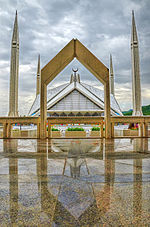
Islam dominates in Pakistan, with about 96.5% of the population being Muslim.[542] Pakistan ranks second globally in Muslim population,[543] and is home to 10.5% of the world's Muslims.[544] Karachi is the largest Muslim city in the world.[545]
The majority follow Sunni Islam, with a significant presence of Sufism, while Shia Muslims constitute a minority.[546][547] Shias represent between 5–25%.[546][381][548] The Shia population in Pakistan was estimated at 42 million in 2019.[549] As of 2012[update], 12% of Pakistani Muslims self-identify as non-denominational Muslims.[550]
The Ahmadis are a minority, officially considered non-Muslims.[551][552] Ahmadis face persecution, banned from calling themselves Muslims since 1974.[553]
Hinduism
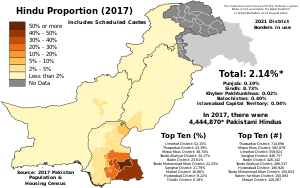
Hinduism is the second-largest religion, followed by 2.14% of the population according to 2017 census.[554][555] Pakistan had the fifth-largest Hindu population globally in 2010.[556] In 2017, Hindus numbered 4,444,437.[557] They reside across Pakistan but are concentrated in Sindh, where they make up 8.73% of the population.[554] Umerkot district is the only Hindu majority area. Tharparkar district hosts the largest Hindu population. Four districts – Umerkot, Tharparkar, Mirpurkhas, and Sanghar – have over half of Pakistan's Hindus.[558]
At Pakistan's inception, the 'hostage theory' suggested fair treatment of Hindus to safeguard Muslims in India.[559][560] However, some Pakistani Hindus felt marginalized, leading to emigration to India.[561] They faced violence post the Babri Masjid demolition,[562] enduring forced conversions and abductions.[563]
Christianity and other religions

Christians are the next largest religious minority after Hindus, constituting 1.27% of the population.[520] They are concentrated in Lahore District (5%) and Islamabad Capital Territory (over 4%). Karachi hosts a historic Roman Catholic community established by Goan and Tamil migrants during British colonial rule.[558]
Following Christianity, the Bahá'í Faith had 30,000 followers in 2008, followed by Sikhism, Buddhism, and Zoroastrianism, each with around 20,000 adherents in 2008,[564] alongside a small Jain community.
In 2005, 1% of the population identified as atheist. By 2012, this figure had risen to 2.0% according to Gallup.[565]
Education

Pakistan's constitution mandates free primary and secondary education,[566] with public universities established in each province, including Punjab University, Sindh University, Peshawar University, Karachi University, and Balochistan University. The country's educational landscape encompasses both public and private universities, fostering collaboration to enhance research and higher education opportunities, albeit with concerns regarding teaching quality in newer institutions.[567] Technical and vocational institutions in Pakistan number approximately 3,193,[568] complemented by madrassahs providing free Islamic education to students,[569] with government efforts to regulate and monitor their quality amidst concerns over extremists recruitment.[570] Education is divided into six main levels, including nursery, primary, middle, matriculation, intermediate, and university programs.[568] Additionally, private schools offer a parallel secondary education system based on the curriculum set by the Cambridge International Examinations,[571] with 439 international schools reported in Pakistan.[572]

Initiatives since 2007 made English medium education mandatory nationwide. Following a 2012 attack on activist Malala Yousafzai by the Taliban, she became the youngest Nobel laureate for her education advocacy.[573] Reforms in 2013 mandated Chinese language courses in Sindh, reflecting China's growing influence. As of 2018, Pakistan's literacy rate stands at 62.3%, with significant regional and gender disparities.[574] Government initiatives, including computer literacy since 1995, aim to eradicate illiteracy, targeting 100% enrollment among primary school-age children and an ~86% literacy rate by 2015.[575] Pakistan allocates 2.3% of its GDP to education,[576] among the lowest in South Asia.[577]
Culture

Civil society in Pakistan is hierarchical, emphasizing local cultural etiquette and traditional Islamic values. The primary family unit is the extended family, but there's a rising trend towards nuclear families due to socio-economic factors.[578][579] Both men and women typically wear Shalwar Kameez; men also favor trousers, jeans, and shirts.[580] The middle class has grown to about 35 million, with another 17 million in the upper and upper-middle classes, leading to a shift in power from rural landowners to urban elites.[581] Festivals like Eid-ul-Fitr, Eid-ul-Azha, Ramadan, Christmas, Easter, Holi, and Diwali are primarily religious.[578] Pakistan ranks 56th on the A.T. Kearney/FP Globalization Index due to increasing globalization.[582]
Architecture

Four periods define Pakistani architecture: pre-Islamic, Islamic, colonial, and post-colonial. The onset of the Indus civilization around the mid-3rd millennium BCE heralded an urban culture, evidenced by surviving large structures.[583] Notable pre-Islamic settlements include Mohenjo-daro, Harappa, and Kot Diji.[584] The fusion of Buddhism and Greek influences birthed a distinctive Greco-Buddhist style from the 1st century CE, exemplified by the renowned Gandhara style.[585] Notable Buddhist architectural remnants include the Takht-i-Bahi monastery in Khyber Pakhtunkhwa.[586]
The advent of Islam in present-day Pakistan marked the cessation of Buddhist architecture, ushering in Islamic architecture. The notable Indo-Islamic structure, the tomb of Shah Rukn-i-Alam in Multan, remains significant. During the Mughal era, Persian-Islamic design merged with Hindustani art, seen in Lahore's architectural gems like the Badshahi Mosque and the Lahore Fort with the iconic Alamgiri Gate. Lahore also boasts the vibrant Wazir Khan Mosque,[587] and the lush Shalimar Gardens. In the British colonial period, Indo-European buildings emerged, blending European and Indian-Islamic styles. Post-colonial identity shines through modern landmarks like the Faisal Mosque, Minar-e-Pakistan, and Mazar-e-Quaid. British architectural influence persists in structures across Lahore, Peshawar, and Karachi.[588]
Clothing, arts, and fashion

The Shalwar Kameez is Pakistan's national dress, worn in all provinces: Punjab, Sindh, Balochistan, Khyber Pakhtunkhwa, and Azad Kashmir. Each province has its own style. Pakistanis wear a variety of fabrics like silk, chiffon, and cotton. In addition to the national dress, men often wear domestically tailored suits and neckties, especially in offices, schools, and social gatherings.[589]
Pakistan's fashion industry has thrived, blending traditional and modern styles to create a unique cultural identity. Regional and traditional dress remain significant symbols of native tradition, evolving into both modern and purer forms. Organizations like the Pakistan Fashion Design Council in Lahore and the Fashion Pakistan Council in Karachi host events like PFDC Fashion Week and Fashion Pakistan Week. Pakistan's inaugural fashion week took place in November 2009.[590]
Literature and philosophy
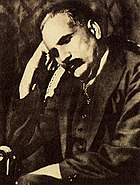
Pakistan boasts literature in various languages including Urdu, Sindhi, Punjabi, Pashto, Baluchi, Persian, English, and more.[591] The Pakistan Academy of Letters actively promotes literature and poetry both domestically and internationally.[592] National Library contributes to literary dissemination. Historically, Pakistani literature consisted mainly of lyric, religious, and folkloric works, later diversifying under colonial influence into prose fiction, now widely embraced.[593][594]
The national poet of Pakistan, Muhammad Iqbal, wrote influential poetry in Urdu and Persian, advocating for Islamic civilizational revival.[595] Notable figures in contemporary Urdu literature include Josh Malihabadi, Faiz Ahmed Faiz, and Saadat Hasan Manto.[594] Popular Sufi poets like Shah Abdul Latif and Bulleh Shah are revered.[596] Mirza Kalich Beg is hailed as the father of modern Sindhi prose.[597] Pakistani philosophy has been shaped by influences from British and American philosophy, with notable figures like M. M. Sharif contributing to its development.[598] Post-1971, Marxist thought gained prominence in Pakistani philosophy through figures like Jalaludin Abdur Rahim.[599]
Media and entertainment
The private print media, state-owned Pakistan Television Corporation (PTV), and Pakistan Broadcasting Corporation (PBC) dominated media until the 21st century. Pakistan now boasts a vast network of domestic, privately owned 24-hour news media and television channels.[600] A 2021 report by the Reporters Without Borders ranked Pakistan 157th among 180 nations on the Press Freedom Index, citing pressures faced by Pakistani reporters, particularly when reporting against the army or government.[601] The BBC describes Pakistani media as "among the most outspoken in South Asia".[602] Pakistani media has been instrumental in exposing corruption.[603]
The Lollywood, Punjabi, and Pashto film industry is centered in Karachi, Lahore, and Peshawar. Although Bollywood films were banned from public cinemas from 1965 to 2008, they remained influential in Pakistani popular culture.[604] However, in 2019, the screening of Bollywood movies faced an indefinite ban.[605] Despite challenges faced by the Pakistani film industry, Urdu televised dramas and theatrical performances remain popular, frequently broadcast by many entertainment media outlets.[606] Urdu dramas dominate the television entertainment industry, renowned for their quality since the 1990s.[607] Pakistani music encompasses diverse forms, from provincial folk music and traditional styles like Qawwali and Ghazal Gayaki to modern fusions of traditional and western music.[608] Pakistan boasts numerous renowned folk singers, and the arrival of Afghan refugees in western provinces has sparked interest in Pashto music, despite occasional intolerance.[609]
Cuisine

Pakistani cuisine, rooted in the royal kitchens of 16th-century Mughal emperors, blends influences from British, Indian, Central Asian, and Middle Eastern culinary traditions.[610] Unlike Middle Eastern fare, Pakistani dishes are heavily spiced with garlic, ginger, turmeric, chili, and garam masala. Roti, a wheat-based flatbread, accompanies most meals, alongside curry, meat, vegetables, and lentils. Rice is also common, served plain, spiced, or in sweet dishes.[179][611] Lassi, a traditional drink from the Punjab region, and black tea with milk and sugar are popular beverages enjoyed nationwide.[580][612] Sohan halwa, a beloved sweet dish from southern Punjab, is savored across Pakistan.[613]
Sports
Cricket is the most popular sport in Pakistan, followed by football. Field hockey is the national sport. Other sports like squash, polo, and traditional games are also enjoyed.
In cricket, Pakistan boasts victories in all major ICC tournaments, including the ICC Cricket World Cup, ICC World Twenty20, and ICC Champions Trophy. The Pakistan Super League ranks among the top T20 leagues globally.[614][615]
In football, Pakistan established the Pakistan Football Federation soon after its creation, and it is known for producing FIFA World Cup balls.[616][617]
In field hockey, Pakistan boasts four Hockey World Cup wins, eight


 French
French Deutsch
Deutsch

